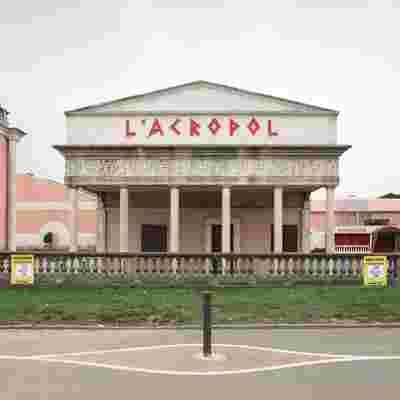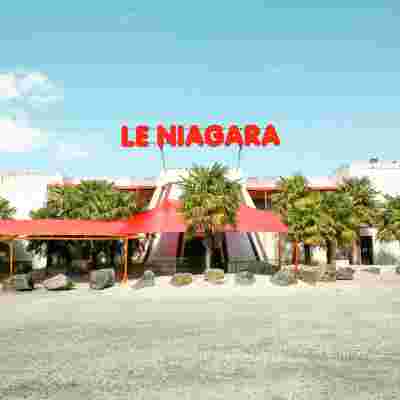In 2011, French photographer François Prost was on a bike trip through Burgundy when he made a pit stop in the parking lot of a nightclub. “I noticed some details of some broken bottles on the floor that suggested a party might have ended a few hours before my arrival, being there on a bike at 10 a said Prost. “Thinking there must have been a crazy party there a few hours before, I felt I should take a picture.”
That one photo led to the start of a photo series of nightclub façades. Prost has spent years traveling through France, photographing a total of 140 nightclubs by day. They’re now compiled in a book called After Party , released by the French publishing house Headbangers Publishing, and is available at Club 75 boutique in Paris . “I started taking pictures of nightclubs during the day to show them in a more ‘objective’ light than usual,” he says. “So, I started to search for many other spots like that, and that made me travel throughout the four corners of France.”
The new book includes sometimes eerie, overblown architecture and neon signage under sunlight, along with a map that shows where each venue is located. Its publication coincides with a solo exhibition of Prost’s photos from the book, which is opening at the Agnès B. boutique in Paris on November 22. Here are some highlights.

L’Acropol nightclub in Chilly-Mazarin, just outside of Paris (today, it’s called L’Empire), is a venue frequented by university students. “It’s nostalgic,” says Prost. “These venues, or any kind of party venue, symbolize the first feeling of freedom when we were teenagers. It’s to see what’s behind the subversive image that the club venues use to seduce the youth to come in and study the different codes connected to a ‘party feeling.’”

The pictures in the book were shot all over France, from Parisian suburbs to airport parking lots and remote clubs on highways. “They’re shot in the four corners of France,” says Prost. “A few were shot in Belgium and one was shot in Spain .” Here is Le Niagara nightclub in Missillac, which is popular for wedding parties. It’s in a region in western France close to Nantes.

Le Stargate is a nightclub in Bignan, in Brittany in northwestern France.
A desolate nightclub in Beaune, in the heart of Burgundy, the winemaking region in France. “It’s not my intention to give a scary feeling to these places,” says Prost. “To me, it’s a documentary approach, and to shoot the places simply as they are.”
Le Sphinx nightclub in Charmes, an area in Grand Est in northeastern France. The façade of this white building has an Egyptian sphinx in its logo. “These nightclubs are shot in the daylight, so of course, they are kind of disconnected to their main function,” he says, “which is a party at night.”
This club, Les Nuits Blanches in Chatenay-Macheron, is one type of European architecture style that spoke to Prost. “It symbolizes western architecture and urbanism from the 1970s and 1980s, up until now,” he says. “Along with fast-growing cities, the leisure industry popped up in the periphery of urban zones.”
There is a recurring theme of palm trees inside and outside of French nightclubs, like this one in Condrieu in the eastern part of France. “Since these places are amusement places, they develop a ‘dreamy’ universe to take you away,” he says. “Most of the time, they use replicas of dreamy elements, and the palm tree is a perfect symbol to make you dream about a tropical feeling.”
Some of the clubs have an almost comical, theme park–like feel. “I noticed replicas of antique Roman low relief, antique Greek columns, Mayan statues, or even spinoffs of clubs like Studio 54, Amnesia, and Caesars Palace,” says Prost.
La Nuit nightclub, graced with imitation Mayan statues, is located in the Montbazens area of southern France, near Toulouse. The palm trees here are real. This nightclub is not known for one genre—some nights they have reggae and hip-hop DJs, while other nights feature country music and square dancing.
La Noche was a nightclub in Lons, an area near the city of Pau in southwestern France; it is now closed. It had a Franco-Portuguese restaurant, two dance floors, and DJs that played African American playlists.
Le Retro nightclub is a discotheque in Oursbelille, a small area in Hautes-Pyrénées that is close to Lourdes. It is in a building that looks a bit like a warehouse, and is known for their Caribbean and west Indian music nights. It advertises free entry for women.
L’Aquarius nightclub in Pont-du-Château in central France, near Lyon. Like many of the nightclubs in the book, it has a lonely feel. “Many people asked me why there are only places that look quite remote,” says Prost. “It’s because I always tried to find venues that are well identifiable, which I tried to do in city centers, but many of the nightclubs were basements with no real façades or outside signs that were really interesting, photographically speaking.”
